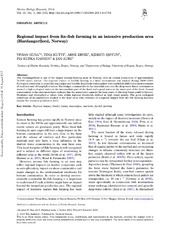Regional impact from fin-fish farming in an intensive production area (Hardangerfjord, Norway)
Peer reviewed, Journal article
Published version

Åpne
Permanent lenke
https://hdl.handle.net/1956/17155Utgivelsesdato
2014Metadata
Vis full innførselSamlinger
Originalversjon
https://doi.org/10.1080/17451000.2013.810754Sammendrag
The Hardangerfjord is one of the largest salmon-farming areas in Norway, with an annual production of approximately 70,000 metric tonnes. The regional impact of fin-fish farming in a fjord environment was studied during 2008–2010. Ecological conditions in intertidal macroalgal and benthic deep basin communities were studied in addition to measurements of nutrients and chlorophyll-a values. Macroalgal communities in the intertidal zone and the deep water fauna communities showed a high ecological status in the intermediate part of the fjord and a good status in the inner part of the fjord. Faunal communities in the outermost basin indicate that the assimilative capacity for farm waste of this deep basin could be limited. Nutrients and chlorophyll-a values were within national thresholds defined as high water quality. The good ecological conditions of the parameters studied in the fjord show little evidence of a regional impact from the fish farming industry despite the intensive production level.